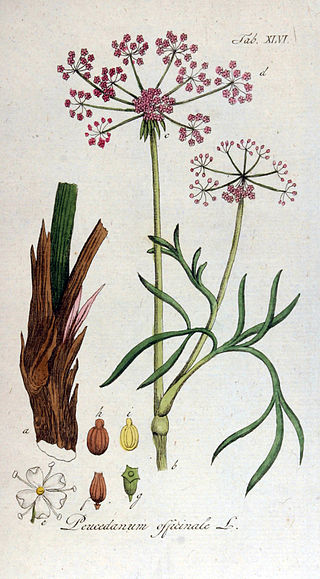
The Agromyzidae are a family of flies, commonly referred to as the leaf-miner flies for the feeding habits of their larvae, most of which are leaf miners on various plants. It includes roughly 2,500 species, they are small, some with wing length of 1 mm. The maximum size is 6.5 mm. Most species are in the range of 2 to 3 mm.

Peucedanum is a genus of flowering plant in the carrot family, Apiaceae. Peucedanum boasts a global presence with diverse spread of morphological features. Peucedanum species are characterized by dorsally compressed mericarps, slightly prominent dorsal ribs, narrowly winged lateral ribs, and a broad commissure. However, the vast diversity of morphology, fruit forms, and phytochemical production makes classifying species in the Peucedanum challenging. Historically relevant in traditional medicine, Peucedanum's taxonomic complexity arises from its extensive diversity.

Agromyza is a genus of flies belonging to the family Agromyzidae. The adults of these flies can be recognised by the presence of stridulatory files on the first two abdominal tergites in both males and females. Another useful identifying feature is the halteres which are usually white or yellow, although they are darker in a few tropical species.

Tselfatia is an extinct genus of Cretaceous bony fish. Originally described from Djebl Tselfat in Morocco, it has since been discovered at sites in several other countries. The type species, Tselfatia formosa, was named and described in 1944 by French paleontologist Camille Arambourg. A second species, T. dalmatica, was named in 1980 from the Dalmatian Coast of Yugoslavia.

Agromyza nigripes is a species of fly in the family Agromyzidae. It is found in the Palearctic. The body is black. The thorax and abdomen are shiny. There are 1 + 4 dorsocentral bristles and 7 rows of acrostical bristles. The wing veins are brown, yellow at the base. Long. : 2–3,5 mm. The larva makes serpentine mines in Medicago sativa leaves.
Sciophila is a genus of fungus gnats in the family Mycetophilidae. There are at least 50 described species in Sciophila.
Mitosynum is a genus of spiny-legged rove beetles in the family Staphylinidae. There is one described species in Mitosynum, M. vockerothi.
Agromyza parvicornis, the corn blotch leafminer, is a species of leaf miner flies in the family Agromyzidae.
Agromyza pseudoreptans is a species of leaf miner flies in the family Agromyzidae. It has been known to feed on Urtica dioica and Urtica pilulifera both of which are nettles.
Agromyza pudica is a species of leaf miner flies in the family Agromyzidae.
Agromyza ambrosivora is a species of leaf miner fly in the family Agromyzidae.
Agromyza sulfuriceps is a species of leaf miner flies in the family Agromyzidae.
Gymnopternus vockerothi is a species of long-legged fly in the family Dolichopodidae.
Agromyza aristata, the elm agromyzid leafminer, is a species of leaf miner fly in the family Agromyzidae. It is widespread throughout eastern North America, creating leaf mines in Ulmus americana.
Agromyza reptans is a species of leaf miner flies in the family Agromyzidae.
Agromyza isolata is a species of leaf miner flies in the family Agromyzidae.

Agromyza albitarsis is a species of leaf miner fly in the family Agromyzidae.
Agromyza diversa is a species of leaf miner flies in the family Agromyzidae.
Agromyza frontella, the alfalfa blotch leafminer, is a species of leaf miner flies in the family Agromyzidae. Larval instars of this species engage in cannibalism.







